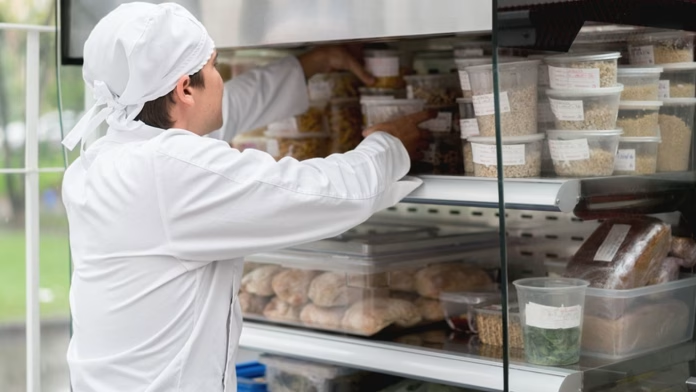As a food business owner, one of the most critical aspects of running a successful operation is efficient inventory management. Whether you own a small café or a large restaurant chain, optimizing your inventory management can help you save time, and money, and increase profits.
Inventory management is the process of overseeing and controlling the flow of goods and materials in a business to ensure that there is enough inventory to meet customer demand while minimizing costs and waste. This includes tracking inventory levels, monitoring sales and orders, and forecasting future demand to ensure that inventory levels are always optimized.
In the food industry, inventory management is particularly important as perishable goods must be closely monitored and managed to ensure that they do not spoil or go to waste. Effective inventory management can help food businesses improve their bottom line by reducing costs, minimizing waste, and improving customer satisfaction.
Inventory management is crucial for the success of any food business. It ensures that the right amount of ingredients and supplies are available when needed, and helps prevent overstocking or stockouts. Proper inventory management allows food businesses to operate efficiently, reduce waste, and increase profitability.
The following are the importance of Inventory Management in food businesses:
1. Efficient operations: Optimizing inventory management ensures that the right amount of ingredients and supplies are available at the right time, eliminating the need for rush orders and last-minute shopping trips. This results in smoother operations, faster service, and increased productivity.
2. Waste reduction: Overstocking ingredients or supplies can lead to spoilage, waste, and increased food costs. On the other hand, running out of key ingredients can lead to delays, unhappy customers, and lost revenue. Proper inventory management helps minimize waste by ensuring that stock levels are appropriate and that ingredients are used before they expire.
3. Cost savings: By optimizing inventory levels, food businesses can reduce the amount of capital tied up in inventory and reduce the cost of carrying inventory. Additionally, accurate inventory data can help businesses negotiate better prices with suppliers and avoid last-minute purchases at higher prices.
4. Improved forecasting: Proper inventory management enables businesses to better predict demand and adjust their purchasing and production accordingly. This results in more accurate forecasting, reduced waste, and improved profitability.
5. Regulatory compliance: Food businesses are subject to strict regulations regarding the storage and handling of food items. Proper inventory management helps ensure that food items are stored appropriately and that they meet regulatory requirements.
Effective inventory management enables businesses to operate efficiently, reduce waste, and increase profitability. Optimizing inventory management is crucial for the success of food businesses.
Here are few ways to optimize inventory management for your food businesses, to maximize profits across your operations.
1. Reducing Food Waste
One of the most significant benefits of optimizing inventory management in food businesses is reducing food waste. When you don’t manage your inventory correctly, you risk over-ordering food supplies that may expire or spoil before you can use them. This results in unnecessary waste, which can have a significant impact on your bottom line. By optimizing your inventory management, you can accurately forecast demand, order the right amount of ingredients, and reduce waste.
2. Lowering Costs
Optimizing inventory management can also help lower costs. When you have excess inventory, it requires additional storage space, which can be expensive. Additionally, holding onto inventory for too long can result in spoilage or obsolescence, leading to wasted money and resources. By accurately managing your inventory, you can reduce the costs associated with excess inventory and wasted resources.
3. Improving Cash Flow
Inventory management is closely tied to cash flow. When you hold excess inventory, it ties up your cash flow and prevents you from investing in other areas of your business. By managing your inventory efficiently, you can free up your cash flow, which can be used to invest in other areas of your business, such as marketing, technology, and expansion.
4. Enhancing Customer Satisfaction
Optimizing inventory management can also enhance customer satisfaction. When you have the right ingredients and supplies on hand, you can quickly prepare orders, avoid stockouts, and ensure that customers receive their orders promptly. On the other hand, if you don’t have the right supplies, you risk delaying orders, disappointing customers, and damaging your reputation.
5. Increasing Productivity
Finally, optimizing inventory management can help increase productivity. When you have an organized system for managing inventory, you can quickly find the supplies you need, reduce the time it takes to prepare orders and avoid unnecessary downtime. This can help you serve more customers and increase profits.
Effective inventory management is a critical factor in the success of any food business. The ability to control inventory levels, minimize waste, and maximize profits are all key benefits that come with optimizing inventory management. By implementing a robust inventory management system and regularly analyzing and adjusting it, food businesses can ensure they are meeting their customers’ demands while also minimizing costs. With the rise of technology and data analytics, food businesses now have access to powerful tools to help them better manage their inventory and streamline their operations. Ultimately, optimizing inventory management is not just about reducing costs or maximizing profits, but also about ensuring customer satisfaction and loyalty, which is essential for long-term success in the competitive food industry.





